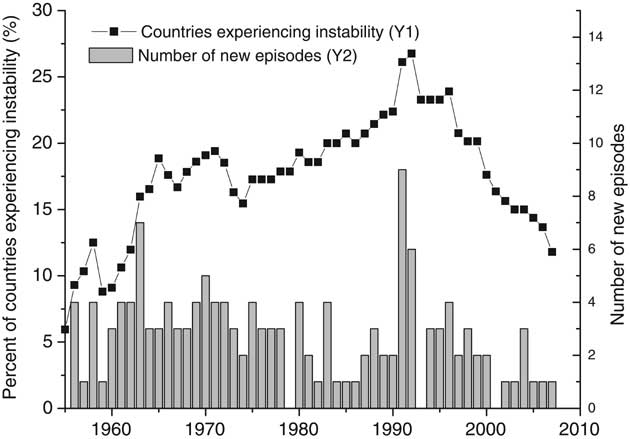
Figure 4-9. Incidence and prevalence of political instability worldwide, 1955-2006. Source: Update of Goldstone et al., 2005.
organizations, such as NEPAD or ECOWAS (Economic Community of West African States) play an increasing role in shaping agricultural policies. Global organizations such as the United Nations Food and Agriculture Organization (FAO), the World Organization for Animal Health, and the Consultative Group on International Agricultural Research (CGIAR) are important players in AKST, as are treaties, e.g., the International Treaty on Plant Genetic Resources, and issue-specific global networks, such as the Global Fund for Control of Highly Pathogenic Avian Influenza. Thus, the ability of the international community to cooperate to provide global public goods for agriculture is an important sociopolitical driver.
4.3.3.6 Sociopolitical factors in existing assessments
Predictive models are available and can be used for formulating future scenarios. Thus far, sociopolitical drivers have been included in assessments as scenario storylines. The IPCC SRES report used the degree of globalization versus regionalization as an important distinction between scenarios. The other axis is the extent to which a scenario focuses on social and environmental objectives versus economic objectives. This basic idea (that relates to several of the factors discussed above) has been further specified in many other scenario studies (MA, 2005a; Westhoek et al., 2005).
4.3.4 Science and technology
Scientific breakthroughs and technological innovations in the last century fueled substantial gains in agricultural productivity in many countries (see FAO statistics). These innovations not only helped meet the world's gross food and fiber needs but, along with new transport and storage technologies, transformed much of northern agriculture from subsistence to commercial market-oriented farming, thus offering more opportunities for participation in global markets. Technology is considered a core driver of future changes, affecting economic growth, social and environmental change and agriculture productivity.
4.3.4.1 Previous Assessments
The Intergovernmental Panel on Climate Change (IPCC, 2000) discusses in detail the approaches and problems encountered in predicting the impact of science and technology on global change. The IPCC identifies five commonalities in the innovation process (Box 4-2). Although the IPCC is particularly concerned with how the innovation process may affect the energy sector, these five commonalities could reasonably be applied to the agricultural sector.
There is widespread agreement that the innovation process is complex and difficult to predict. There is still no agreement on what assumptions to make regarding (1) how government and investment in industrial research and development (R&D) will impact the innovation process, (2) the motivation of producers of new technologies and (3) the role of consumers. Therefore, models and assessments mostly describe technology change in much more aggregated parameters such as exogenously assumed yield changes or learning-by-doing functions (e.g., for production costs of energy technologies). Different assumptions concerning these technology parameters have been used as important drivers to contrast the IPCC-SRES scenarios, i.e., technology change was assumed to be lower in scenarios with less globalization (resulting in lower yield improvement and less rapid economic growth). IPCC-SRES scenarios have also been built around the direction of technology change (IPCC, 2000).
The Millennium Ecosystem Assessment (MA, 2005a) recognizes science and technology as a major driver of change in ecosystems and their services. The MA identified three key concerns regarding technological trends. First, the institutions needed to foster the research and development process are not yet well established in much of the developing world. Secondly, the rate of spread of new technologies may be outpacing the time frame required to identify and address their negative consequences. Lastly, technologies can produce unexpected consequences that might lead to disruptions of ecosystems affecting large numbers of people. Like in the IPCC-SRES scenarios, the rate of technology change was used to contrast the different MA scenarios (Figure 4-10).
Box 4-2. Five commonalities in the innovation process.
1. The process is fundamentally uncertain: outcomes cannot be predicted. 2. Innovation draws on underlying scientific or other knowledge. 3. Some kind of search or experimentation process is usually involved. 4. Many innovations depend on the exploitation of "tacit knowledge" obtained through "learning by doing" or experience. 5. Technological change is a cumulative process and depends on the history of the individual or organization involved.